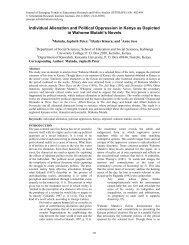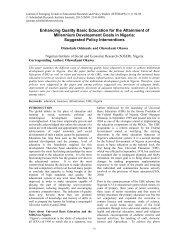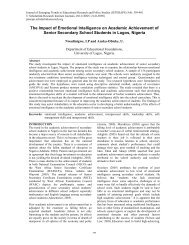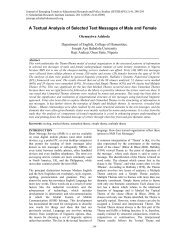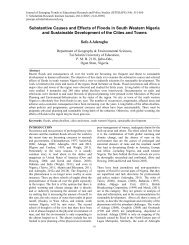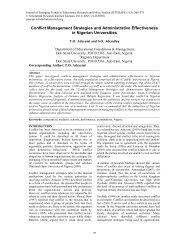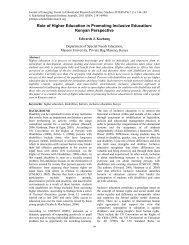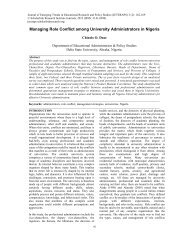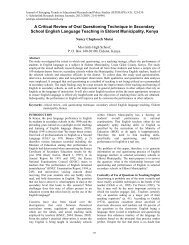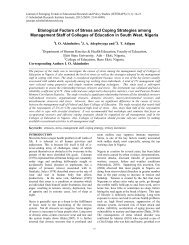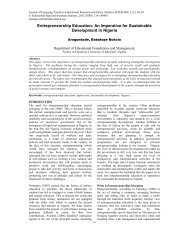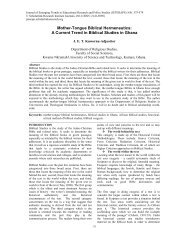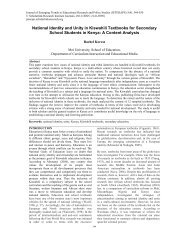The Influence of Secondary Schools Teachers' Distribution of ...
The Influence of Secondary Schools Teachers' Distribution of ...
The Influence of Secondary Schools Teachers' Distribution of ...
You also want an ePaper? Increase the reach of your titles
YUMPU automatically turns print PDFs into web optimized ePapers that Google loves.
Journal <strong>of</strong> Emerging Trends in Educational Research and Policy Studies (JETERAPS) 4(1): 164-169<br />
Journal © Scholarlink <strong>of</strong> Emerging Research Trends Institute in Educational Journals, 2013 Research (ISSN: and 2141-6990) Policy Studies (JETERAPS) 4(1):164-169 (ISSN:2141-6990)<br />
jeteraps.scholarlinkresearch.org<br />
<strong>The</strong> <strong>Influence</strong> <strong>of</strong> <strong>Secondary</strong> <strong>Schools</strong> Teachers’ <strong>Distribution</strong> <strong>of</strong><br />
Student Responsibilities on the Learners’ Perception <strong>of</strong> Gender<br />
Equality in Uasin-Gishu County, Kenya<br />
1 Alice Limo and 2 Shadrack Kipruto Morogo<br />
1 Department <strong>of</strong> Curriculum and Instruction,<br />
Mount Kenya University, P.O. BOX 2591 - 30100, Eldoret, Kenya.<br />
2 Department <strong>of</strong> Humanities,<br />
Legebet <strong>Secondary</strong> School, P.O. BOX 1191 - 30100, Eldoret, Kenya.<br />
Corresponding Author: Alice Limo<br />
___________________________________________________________________________<br />
Abstract<br />
This paper examines the relationship between secondary school teachers’ distribution <strong>of</strong> student responsibilities<br />
on the learners’ perception <strong>of</strong> gender equality. It is based on a study conducted in Uasin-Gishu County in<br />
Kenya. <strong>The</strong> purpose <strong>of</strong> the study was to establish the relationship between the hidden curriculum and gender<br />
equality amongst secondary school students. <strong>The</strong> authors adopted a survey research design. <strong>The</strong> target<br />
population consisted <strong>of</strong> the accessible population was the selected students in sampled mixed schools in the<br />
area. Proportionate stratified sampling technique was used to select 21 schools. Stratified random sampling<br />
based on gender was used to obtain the representative sample <strong>of</strong> 271 participants. <strong>The</strong> authors used<br />
questionnaires and document analysis as the main tools for collection <strong>of</strong> data. <strong>The</strong> collected data was coded<br />
using the Statistical Package for Social Sciences (SPSS), analysed both quantitatively and qualitatively, and then<br />
presented using descriptive statistics. It was found that the teachers failed to promote gender equality amongst<br />
the students in assignment <strong>of</strong> responsibilities and rather believed that certain duties were masculine while others<br />
were feminine responsibilities, a situation that further promoted gender inequality amongst the students. As<br />
such, it was recommended that teachers be sensitized through seminars and workshops on the need to provide<br />
equal opportunities as well as the need to change attitudes towards girls, especially as regards girls’ interest and<br />
performance in Mathematics and Technological subjects. <strong>Schools</strong> must focus on reversing the traditional<br />
allocation <strong>of</strong> responsibilities and roles to girls and boys in order to build and shape them towards equality. <strong>The</strong><br />
study is important both scholars and general readers as it sheds light to teachers and aids in understanding the<br />
effects <strong>of</strong> the attitudes, assumptions and expectations that may be placed on the students and therefore cause the<br />
gender gap.<br />
__________________________________________________________________________________________<br />
Keywords: influence, secondary, schools, teachers, distribution, student, responsibilities, learners, Kenya.<br />
__________________________________________________________________________________________<br />
INTRODUCTION<br />
Gender issues have continued to play a key role in the<br />
formulation <strong>of</strong> public policy, not least in the<br />
education sector, where the gender gap in many<br />
developing countries remains a challenge (Sifuna et<br />
al., 2006). It is, however, important to understand the<br />
process <strong>of</strong> policy formulation because it is crucial to<br />
the final outcome <strong>of</strong> its implementation. In<br />
contemporary educational theory and practice,<br />
feminist thought provides invaluable direction on<br />
gender policies that seek to enhance inclusiveness<br />
and equality in education (Sifuna et al., 2006). <strong>The</strong><br />
Sessional paper No. 1 <strong>of</strong> 2005 (GoK, 2005) points to<br />
the support and implementation <strong>of</strong> affirmative action<br />
in secondary education to address the needs <strong>of</strong> the<br />
marginalized and/or those in difficult circumstances<br />
and the need to ensure that the school environment is<br />
gender and special needs education responsive.<br />
Sifuna et al. (2006), however, point out how<br />
education policies reveal the absence <strong>of</strong><br />
comprehensive gender policy with specific<br />
Monitoring and Evaluation guidelines. Further, the<br />
Kenya Government hardly provides effective<br />
guidelines on how to ensure that schools are, not<br />
only, learner-friendly, but also that girls are made to<br />
feel safe at school. Further, unless the policies are<br />
explicit on girls’ educational needs, the gender gap<br />
would continue to be skewed in favour <strong>of</strong> the boys.<br />
<strong>The</strong>re is therefore need to address gender issues<br />
within the broader policy concerns and in the context<br />
<strong>of</strong> the global focus <strong>of</strong> EFA, the MDG’s and other<br />
international conventions and treaties that advocate<br />
equal education for every person.<br />
Some <strong>of</strong> the key international treaties, according to<br />
Chege et al. (2006), include:<br />
(a) <strong>The</strong> international Convention on Civil and<br />
Political Rights (ICCPR) which was adopted<br />
in 1966 and came into force 10 years later in<br />
1976, albeit with a limited coverage <strong>of</strong><br />
gender and education issues.<br />
164
Journal <strong>of</strong> Emerging Trends in Educational Research and Policy Studies (JETERAPS) 4(1):164-169 (ISSN:2141-6990)<br />
(b) <strong>The</strong> Convention on the Elimination <strong>of</strong> all<br />
Forms <strong>of</strong> Discrimination against Women<br />
(CEDAW), which was developed<br />
specifically with gender in mind and<br />
adopted in 1976.<br />
(c) <strong>The</strong> Convention on the Rights <strong>of</strong> the Child<br />
(CRC) that was adopted in 1989 and came<br />
into force in 1990.<br />
Although in full support <strong>of</strong> the MDGs, the Ministry<br />
<strong>of</strong> Education’s statements <strong>of</strong> objectives <strong>of</strong> education<br />
are gender neutral. <strong>The</strong> Kenyan Education system<br />
aims to:<br />
Improve quality <strong>of</strong> human life by imparting<br />
knowledge which will enable individuals to<br />
be self-reliant ….. the education system aims<br />
at removing social injustices and disparities<br />
between sexes, regions , social and economic<br />
groups. It also aims at preparing the youth to<br />
realize their full potential and practice the<br />
norms and values <strong>of</strong> society. In other words<br />
the basic guiding philosophy in education has<br />
remained that <strong>of</strong> producing individuals who<br />
are properly socialized and who possess<br />
necessary skills, attitudes and values to<br />
participate positively in nation building<br />
(GOK National Development Plan, 1994-<br />
1996, p. 215-216).<br />
<strong>The</strong> philosophy <strong>of</strong> education, as stated above, is also<br />
spelt out in Sessional Paper No. 10 <strong>of</strong> 1965 on<br />
African socialism and its application to planning in<br />
Kenya, which calls for political equality, human<br />
dignity, social justice and equal opportunities for all<br />
citizens (Masiga, 1994). Based on the philosophy <strong>of</strong><br />
equal opportunities for all citizens, the broad<br />
educational policies reiterate the national goals <strong>of</strong><br />
education which state that: education should promote<br />
social equality and foster a sense <strong>of</strong> social<br />
responsibility within an educational system which<br />
provides equal educational opportunities for all (boys<br />
and girls, men and women). Another goal <strong>of</strong><br />
education states that education should provide equal<br />
opportunities for fullest development <strong>of</strong> the<br />
individual talents and personality. It should help<br />
every child to develop his/her potential interests and<br />
abilities. <strong>The</strong> policy on equal opportunities does not<br />
discriminate against girls and women (Masiga, 1994).<br />
<strong>The</strong> Role <strong>of</strong> Teachers in Promotion <strong>of</strong> Gender<br />
Equality<br />
Challenging the issues <strong>of</strong> sexism in schools is <strong>of</strong><br />
crucial importance, especially when we consider that<br />
a person’s early experiences can be vital in<br />
determining her or his later attitudes and<br />
expectations. Weiner (1985) points out factors that<br />
contribute to sexism in schools. It is argued that<br />
children are born into a sexist society, where women<br />
do not have equal opportunities and therefore, girls<br />
and boys have different experiences and expectations<br />
<strong>of</strong> themselves, which are formed by society’s<br />
attitudes as to what is appropriate for girls and boys.<br />
Weiner (1985) further argues that “these attitudes<br />
lead to male and female stereotyping. <strong>The</strong>re is a<br />
strong pressure on both sexes to conform to these<br />
stereotypes even if they lead to conflict in their own<br />
lives” (p. 134).<br />
<strong>The</strong> female stereotype holds that girls and women are<br />
passive, nurturing, emotional and impractical. <strong>The</strong><br />
characteristics <strong>of</strong> male stereotype are activity,<br />
aggression, dominance and technical pr<strong>of</strong>iciency.<br />
Female exclusion from science and technology, even<br />
if it is apparently by girls’ own choice, also means<br />
that, as citizens, their ability to understand and<br />
control their environment will be limited (Whyte,<br />
1985). Nevertheless, most schools feel they are<br />
already providing equal opportunities by neutral<br />
treatment <strong>of</strong> the two sexes (Bloomfield, 1984). In<br />
effect ignoring the effects <strong>of</strong> gender in this way<br />
merely reinforces stereotyping because it does<br />
nothing to challenge the definition <strong>of</strong> certain aspects<br />
<strong>of</strong> the curriculum as masculine or feminine. An<br />
Action research in Great Manchester in Britain that<br />
involved 8 co-educational institutions, dubbed ‘Girls<br />
Into Science and Technology (GIST)’, has revealed<br />
how ‘Teachers and boys seemed to be unthinkingly<br />
collaborating to construct science as an area <strong>of</strong><br />
masculine endeavour, excluding girls who quickly<br />
took the hint (Kelly, as cited in Whyte, 1985). <strong>The</strong><br />
GIST interventions strove to redress the numerical<br />
imbalance by <strong>of</strong>fering female role models <strong>of</strong><br />
practicing scientists and establishment <strong>of</strong> single sex<br />
classes among other issues (Whyte, 1985).<br />
Teachers are faced with the challenge <strong>of</strong> identifying<br />
common experiences <strong>of</strong> discrimination against girls.<br />
<strong>The</strong>re is also need for practical ideas <strong>of</strong> <strong>of</strong>fering girls<br />
equality through own teaching and working on<br />
projects that deliberately raise and challenge the issue<br />
<strong>of</strong> sexism (Weiner, 1985). A survey <strong>of</strong> teachers’<br />
attitudes on equal opportunities in British schools<br />
revealed that men were more likely to be opposed to<br />
promoting equal opportunities than women but that<br />
differences in subjects taught were more important<br />
than the sex <strong>of</strong> the teacher (Whyte, 1985).<br />
<strong>The</strong> conditions for a girl-friendly school<br />
may be more difficult to bring about, for it<br />
would seem that teachers must be openly<br />
and visibly concerned about equality before<br />
pupils will change their choices; schools<br />
with traditional norms, limited or formal<br />
communications channels, with few<br />
women in senior positions will be much<br />
slower to adapt to changed female<br />
expectations” (Whyte, 1985, p. 90).<br />
Chege et al. (2006) observe that the teachers’<br />
influences at school have been found to be a<br />
hindrance to girls opting for science and<br />
165
Journal <strong>of</strong> Emerging Trends in Educational Research and Policy Studies (JETERAPS) 4(1):164-169 (ISSN:2141-6990)<br />
mathematics. Studies have shown that teachers tend<br />
to carry the societal expectations <strong>of</strong> girls into the<br />
school, and therefore treat boys differently from girls.<br />
Some teachers are said to actually discourage girls by<br />
uttering statements such as “mathematics and science<br />
are not meant for girls” (Wamahiu et al., as cited in<br />
Chege et al., 2006). A survey <strong>of</strong> co-educational<br />
schools in Britain revealed how many teachers paid<br />
insufficient attention to the ways in which boys<br />
dominated the classroom. Teachers in mixed schools<br />
tended to assume that the presence <strong>of</strong> girls and boys<br />
ensured equal opportunities. In this regard, many<br />
mixed schools failed to tackle equality issues and did<br />
not take advantage <strong>of</strong> the opportunity they had to<br />
bring boys and girls together in discussions about<br />
shared and differing expectations (Riley, 1994).<br />
Frith and Mahony (1994) point out how it is much<br />
harder to elicit reasonable behaviour from pupils who<br />
perceive one (teacher) to be <strong>of</strong> low status. “This is<br />
part <strong>of</strong> a much wider problem to do with how boys<br />
(and perhaps some girls, too) perceive women,<br />
outside <strong>of</strong> the exceptional power relationships within<br />
the classrooms, and any action should certainly<br />
attempt to address the wider issue through work with<br />
pupils as much as with adult members <strong>of</strong> any society<br />
” (Frith & Mahony, 1994, p 70).<br />
STATEMENT OF THE PROBLEM<br />
Since education is recognized as a tool for achieving<br />
social mobility, it should endow individuals with the<br />
skills and qualifications to take up social<br />
responsibilities, without any bias in regard to gender.<br />
Examination results in Uasin Gishu District reveal<br />
how girls continue to perform much lower than the<br />
boys. Girls in mixed school set-ups do not feature as<br />
top performers as already mentioned. <strong>The</strong> study<br />
therefore was focused on assessing how the teachers’<br />
distribution <strong>of</strong> responsibilities amongst students<br />
sends messages to the students in regard to gender<br />
equality in mixed schools in Uasin-Gishu County.<br />
LIMITATIONS OF THE STUDY<br />
During the study, the authors noted the respondents’<br />
unwillingness to freely comment about the school<br />
administration. This posed a danger on the reliability<br />
<strong>of</strong> the study findings as some might distort<br />
information to play safe within the strict school rules.<br />
<strong>The</strong> authors however assured them <strong>of</strong> the<br />
confidentiality <strong>of</strong> the research process. In addition,<br />
perception is an issue that is influenced by a set <strong>of</strong><br />
factors including formal curriculum and cocurriculum,<br />
apart from the hidden curriculum. <strong>The</strong><br />
study focused only on the aspect <strong>of</strong> teachers’<br />
distribution <strong>of</strong> responsibilities to students as part <strong>of</strong><br />
the hidden curriculum. Other factors may also<br />
influence students’ perception <strong>of</strong> gender equality.<br />
Nevertheless, the study sheds light on the importance<br />
<strong>of</strong> the hidden curriculum aspects to students’ life both<br />
in and after <strong>of</strong> school.<br />
MATERIALS AND METHODS<br />
This study was carried out in Uasin-Gishu County,<br />
Rift Valley Province in the Republic <strong>of</strong> Kenya. <strong>The</strong><br />
authors adopted a survey research design in<br />
investigating the relationship between the aspects <strong>of</strong><br />
hidden curriculum and gender equality. <strong>The</strong> authors<br />
used this design to study the relationship between<br />
staff distribution <strong>of</strong> responsibilities to students and<br />
gender equality in mixed public secondary schools.<br />
<strong>The</strong> target population consisted <strong>of</strong> the accessible<br />
population was the selected students in sampled<br />
mixed schools in the area. All the respondents were<br />
either day scholars or boarders. <strong>The</strong> respondents in<br />
selected schools engaged in co-curricular activities<br />
apart from pursuing their academic studies. <strong>The</strong>y<br />
comprised all students from form one to form four in<br />
the selected schools.<br />
Proportionate stratified sampling technique was used<br />
to select 21 schools from the seven divisions, namely<br />
Soy, Turbo, Kaptagat, Kesses, Kapsaret, Ainakboi<br />
and Moiben. <strong>The</strong> sample was drawn from 21 schools<br />
spread across 7 divisions. Stratified random sampling<br />
based on gender was used to obtain the representative<br />
sample <strong>of</strong> 271 participants. <strong>The</strong> authors used<br />
questionnaires and document analysis as the main<br />
tools for collection <strong>of</strong> data. Apart from that, minutes<br />
that showed composition <strong>of</strong> Board <strong>of</strong> Governors for<br />
the purpose <strong>of</strong> detailed analysis and interpretation<br />
were looked at. <strong>The</strong> authors also examined the<br />
schools’ organization charts or school hierarchical<br />
structures to determine staff distribution. <strong>The</strong><br />
collected data was coded using the Statistical<br />
Package for Social Sciences (SPSS), analysed both<br />
quantitatively and qualitatively, and then presented<br />
using descriptive statistics.<br />
RESULTS AND DISCUSSION<br />
<strong>The</strong> main research objective was to determine how<br />
teachers distribute responsibilities to students and its<br />
effect on students’ perception on gender equality. <strong>The</strong><br />
authors asked the respondents to answer six questions<br />
on a Likert-type <strong>of</strong> scale to assess the teachers’<br />
distribution <strong>of</strong> responsibilities. <strong>The</strong> alternative<br />
response questions were asked as well as an openended<br />
question to determine gender equality<br />
perceptions amongst the students.<br />
Head Teachers’ Preference <strong>of</strong> Head Boy<br />
<strong>The</strong> authors sought opinions <strong>of</strong> respondents to the<br />
statement: “<strong>The</strong> Head Teacher Would Easily Pick On<br />
the Head Boy to Address an Important School<br />
Function”. A total <strong>of</strong> 266 participants responded to<br />
this item, while the remaining 6 skipped it. A total <strong>of</strong><br />
266 students responded to this item out <strong>of</strong> which the<br />
highest majority <strong>of</strong> 79(29.7%) agreed that the head<br />
teacher can easily pick on the head boy to address<br />
important school meetings. <strong>The</strong> second highest<br />
category strongly agreed with 65(24.4%) respondents<br />
the rest <strong>of</strong> responses were 52(19.5%), 55(20.7%) and<br />
166
Journal <strong>of</strong> Emerging Trends in Educational Research and Policy Studies (JETERAPS) 4(1):164-169 (ISSN:2141-6990)<br />
15(5.6%) for strongly disagree, disagree and<br />
undecided respectively. <strong>The</strong> results above depict the<br />
head teacher’s confidence in the head boy and how he<br />
is allowed to interact with the outside public in<br />
preparation for equivalent roles after school. <strong>The</strong><br />
head girl’s position, on the other hand, is down<br />
played in the quest to unknowingly or unconsciously<br />
teach her, her position in the social world. <strong>The</strong><br />
authors therefore noted that head teachers, majority<br />
<strong>of</strong> who were male, were promoting gender inequality<br />
the mixed school set up.<br />
Preference <strong>of</strong> Head Boy to Head Girl<br />
<strong>The</strong> authors assessed the preference <strong>of</strong> the head boy<br />
over the head girl in addressing <strong>of</strong> school meetings<br />
by asking for opinions regarding the statement: “<strong>The</strong><br />
Head Boy Is Often Asked By Teachers to Address<br />
Important School Meetings than the Head Girl”. <strong>The</strong><br />
authors wished to check whether or not the teachers<br />
discriminate between the two genders in terms <strong>of</strong> the<br />
opportunity to address school meetings. Table 1<br />
presents the findings.<br />
Table 1: Teachers Speech Address Assignment to<br />
Head Boy Compared to Head Girl<br />
Type<br />
Response<br />
<strong>of</strong><br />
Frequency by<br />
Gender<br />
Male Female<br />
Total<br />
Frequency<br />
SD<br />
DA<br />
UN<br />
A<br />
SA<br />
13<br />
41<br />
21<br />
44<br />
19<br />
31<br />
33<br />
11<br />
25<br />
27<br />
44<br />
74<br />
32<br />
69<br />
46<br />
16.6<br />
27.9<br />
12.1<br />
26.0<br />
17.4<br />
Total 138 127 265 100<br />
<strong>The</strong> highest group <strong>of</strong> respondents was those who<br />
disagreed, 74(27.9%), followed by those who agreed,<br />
69(26.0%). It must be noted that the difference<br />
between those who agreed and those who disagreed is<br />
generally insignificant. <strong>The</strong> difference between the<br />
respondents who accepted or agreed to this item and<br />
those who disagreed is quite insignificant, even<br />
though a simple majority disagreed.<br />
Boys and Cleaning Assignments<br />
<strong>The</strong> authors sought opinions on whether or not the<br />
teachers would easily assign boys any cleaning<br />
assignments, by asking the respondents to give their<br />
opinions on the item: “Teachers would easily ask<br />
boys to clean tables in the staff room.” A total <strong>of</strong> 267<br />
students responded to the item, the rest having<br />
skipped it. A total <strong>of</strong> 267 respondents gave answers<br />
to the item. A clear majority <strong>of</strong> 125(47.0%) Strongly<br />
Disagreed with the item. <strong>The</strong> second highest category<br />
is those who Disagreed having been 74(27.8%). <strong>The</strong><br />
rest <strong>of</strong> the respondents were 26(9.8%), 18(6.8%) and<br />
23(8.6%) for Undecided.<br />
<strong>The</strong>se results clearly depict the extent <strong>of</strong> latent<br />
discrimination in mixed school set-ups. It so appears<br />
%<br />
here that teachers already have firm ideas about the<br />
respective roles <strong>of</strong> students in life and what they<br />
could be unconsciously doing is reaffirming the<br />
responsibilities to the learners who may have also<br />
developed the attitudes at an earlier age. <strong>The</strong>se<br />
teachers’ attitudes and tendencies towards students<br />
work to promote gender inequality amongst students<br />
in mixed schools.<br />
Teachers Asking Girls to Clean Tables<br />
<strong>The</strong> authors sought to find out whether or not the<br />
belief that certain duties such as cleaning were still in<br />
the domain <strong>of</strong> girls by asking for views on the<br />
statement: “Teachers Can Readily Pick On Girls To<br />
Do A Cleaning Assignment.” Table 2 presents the<br />
findings.<br />
Table 2: Perception <strong>of</strong> Cleaning Assignment to Girls<br />
Type <strong>of</strong><br />
Response<br />
Frequency by Gender Total %<br />
Male Female Frequency<br />
SD<br />
DA<br />
UN<br />
A<br />
SA<br />
19<br />
41<br />
10<br />
40<br />
31<br />
15<br />
26<br />
7<br />
33<br />
44<br />
34<br />
67<br />
17<br />
73<br />
75<br />
12.8<br />
25.2<br />
6.4<br />
27.4<br />
28.2<br />
Total 141 125 266 100<br />
According to the John Rawls <strong>The</strong>ory <strong>of</strong> Justice, there<br />
is a need for equality <strong>of</strong> opportunity within the school<br />
system. In this case, basic rights and duties should be<br />
assigned to all individuals without any bias as regards<br />
gender. When respondents were asked to respond to<br />
the item on assignment <strong>of</strong> responsibility <strong>of</strong> cleaning<br />
to girls, a clear majority <strong>of</strong> 75(28.2%) Strongly<br />
Agreed. <strong>The</strong> second highest category Agreed with<br />
73(27.4%) respondents. <strong>The</strong> rest <strong>of</strong> the respondents<br />
were 34(12.8%), 67(25.2%) and 17(6.4%) for<br />
Strongly Disagree, Disagree and Undecided<br />
respectively.<br />
When the item on assignment <strong>of</strong> cleaning to boys is<br />
compared with the one on assignment <strong>of</strong> cleaning to<br />
girls, it comes out clearly that cleaning is within the<br />
domain <strong>of</strong> girls. <strong>The</strong> mixed school set up is therefore<br />
clearly seen to be perpetrating the traditional sexist<br />
culture. In order to change the perceptions <strong>of</strong> the<br />
students we therefore must begin by helping the<br />
teachers to overcome their well-documented<br />
unwillingness to transcend the discriminatory<br />
practices <strong>of</strong> culture.<br />
Girls Offloading Heavy Laboratory Equipment<br />
<strong>The</strong> authors wished to find out whether or not<br />
teachers felt that both boys and girls could do hard<br />
tasks without any discrimination by asking for<br />
opinions on: “Teachers Can Ask Girls To <strong>of</strong>f Load<br />
Heavy Laboratory Equipments from a Vehicle”.<br />
When asked whether or not girls could <strong>of</strong>fload heavy<br />
laboratory equipment from a vehicle, 187(69.5%)<br />
respondents Strongly Disagreed. This very strong,<br />
167
Journal <strong>of</strong> Emerging Trends in Educational Research and Policy Studies (JETERAPS) 4(1):164-169 (ISSN:2141-6990)<br />
and almost unanimous disagreement, points out the<br />
s<strong>of</strong>t treatment that girls receive in a mixed school setup.<br />
Weiner (1989) warns about s<strong>of</strong>t treatment that<br />
girls could receive in a mixed school set-up. <strong>The</strong><br />
principle <strong>of</strong> equality <strong>of</strong> opportunity should allow<br />
every group to do even heavy tasks without any bias<br />
as regards gender.<br />
<strong>The</strong>se results depict the hidden discrimination that<br />
girls receive in the school system. Eventually, the<br />
girls will lose interest in heavy assignments and<br />
certain careers that require the physical strength such<br />
as engineering, architecture and other science related<br />
courses. Weiner (1989) points out how it may take<br />
the experience <strong>of</strong> a mixed educational school to<br />
firmly instil social training to students. Eventually,<br />
the social injustice <strong>of</strong> systematic discrimination<br />
against women will become accepted as normal.<br />
Girls Often Asked To Construct Tents for School<br />
Functions<br />
<strong>The</strong> item “Girls Are Often Asked To Construct Tents<br />
for School Functions,” was meant to test whether or<br />
not teachers believed that the two genders are equal<br />
and should be treated equally. Table 3 presents the<br />
findings.<br />
A total <strong>of</strong> 146(54.7%) students strongly disagreed<br />
with this item. <strong>The</strong> second highest percentage was<br />
those who disagreed, constituting a total <strong>of</strong><br />
61(22.8%) respondents. <strong>The</strong> rest <strong>of</strong> the responses<br />
were 19(7.1%), 18(6.7%), 23(8.6%) for Undecided,<br />
Agree and Strongly Agree respectively.<br />
Table 3: Frequency <strong>Distribution</strong> <strong>of</strong> Respondents by<br />
<strong>The</strong>ir Responses to Girls Construction <strong>of</strong> Tents for<br />
School Functions<br />
Type<br />
Response<br />
SD<br />
DA<br />
UN<br />
A<br />
SA<br />
<strong>of</strong><br />
Frequency by Total %<br />
Gender<br />
Male Female Frequency<br />
70 76 146 54.7<br />
29 32 61 22.8<br />
14 5 19 7.1<br />
14 4 18 6.7<br />
13 10 23 8.6<br />
Total 140 127 267 100<br />
<strong>The</strong> results in Table 3 clearly depict a school system<br />
where certain duties are seen as masculine and others<br />
feminine. In such a situation <strong>of</strong> gender<br />
differentiation, the students’ very capacity to learn,<br />
and in particular, their construction <strong>of</strong> social<br />
representation <strong>of</strong> gender which value things<br />
masculine more than things feminine, is the ultimate<br />
undoing for girls. This finding is definitely supported<br />
by Kelly (as cited in Lloyd et al., 1992) who points<br />
out that girls learn that they occupy an identifiable<br />
and different place in an educational system to that <strong>of</strong><br />
boys.<br />
Teachers’ Assignment <strong>of</strong> Differentiated<br />
Responsibilities<br />
<strong>The</strong> question “Do You Think Teachers Assign<br />
Differentiated Responsibilities Such As Cleaning Or<br />
Construction To Boys and Girls In This School” was<br />
meant to see the role the school system through its<br />
teachers play in promotion <strong>of</strong> gender equality<br />
amongst the students. This was an alternative<br />
response question where a significant majority <strong>of</strong><br />
students, 160(59%), accepted that teachers did assign<br />
differentiated responsibilities according to the<br />
learners’ gender. A total <strong>of</strong> 110 respondents (41%)<br />
said that the responsibilities were similar. Although<br />
there were no significant differences between the<br />
males who said ‘no’ or ‘yes’, it is the significant<br />
majority <strong>of</strong> females who noted the discrimination that<br />
the teachers made in this case. A total <strong>of</strong> 90 female<br />
students accepted that there was discrimination<br />
compared to 40 who said there was no<br />
discrimination. It is quite clear that teachers in mixed<br />
schools discriminate against students in assignment<br />
<strong>of</strong> responsibilities, thus promoting gender inequality.<br />
Details <strong>of</strong> Differentiated Responsibilities<br />
<strong>The</strong> authors sought to establish the kinds <strong>of</strong><br />
responsibilities that teachers assigned to each gender.<br />
Some <strong>of</strong> the students pointed out that boys generally<br />
managed the ‘heavy’ duties. This group consisted <strong>of</strong><br />
151 respondents. Another group <strong>of</strong> 148 identified<br />
fencing and gardening being done by the boys’.<br />
Fetching water and transportation <strong>of</strong> heavy things<br />
was also pointed out by a significant number <strong>of</strong><br />
students as boys’ assignments. <strong>The</strong> responsibilities<br />
pointed out for girls included cleaning classes and<br />
toilets as pointed out by 153 respondents. Some <strong>of</strong><br />
the respondents pointed out kitchen work as a domain<br />
for girls. Girls were also supposed to ensure<br />
cleanliness <strong>of</strong> the compound as reported by 147<br />
respondents.<br />
It may be concluded here that the female students are<br />
keener and sensitive to any differences in the<br />
activities they do. Lloyd et al. (1992) are quick to<br />
warn that the girls’ capacity to learn the social<br />
representation <strong>of</strong> gender, which values things<br />
masculine more than things feminine and which place<br />
men in more privileged positions, is the ultimate<br />
undoing for girls.<br />
Boys’ Willingness to do Girls’ Responsibilities<br />
<strong>The</strong> question “If Teachers Assign Differentiated<br />
Responsibilities, Do You Think Boys Would Be<br />
Willing To Do the Responsibilities for Girls” was<br />
used to survey the students’ altitudes towards female<br />
students’ responsibilities. Table 4 illustrates the<br />
findings.<br />
168
Journal <strong>of</strong> Emerging Trends in Educational Research and Policy Studies (JETERAPS) 4(1):164-169 (ISSN:2141-6990)<br />
Table 4: Boys’ Willingness to take up Girls’<br />
Responsibilities<br />
Type <strong>of</strong> Frequencies by Total<br />
Response Gender<br />
%<br />
Male Female Frequency<br />
Yes 47 47 94 35.2<br />
No 91 82 173 64.8<br />
Total 138 129 267 100<br />
<strong>The</strong> authors wished to investigate whether or not the<br />
respondents had attained a level <strong>of</strong> gender equality<br />
where a responsibility would not be looked down<br />
upon on the basis <strong>of</strong> association with gender. This<br />
was an alternative response question. It was found<br />
out that the boys were unwilling to do girls’<br />
assignments. A majority <strong>of</strong> students, 173(64.8%),<br />
mentioned this unwillingness. <strong>The</strong> other 94(35.2%)<br />
respondents said the boys were willing to take up<br />
girls’ responsibilities. Table 4 depicts how both male<br />
and female students think that boys are not willing to<br />
take up girls’ responsibilities. <strong>The</strong> study established<br />
that the mixed school system served to reinforce the<br />
social trends about men’s and women’s<br />
responsibilities.<br />
CONCLUSION AND RECOMMENDATIONS<br />
From the study, it was established that the teachers<br />
failed to promote gender equality amongst the<br />
students in assignment <strong>of</strong> responsibilities and rather<br />
believed that certain duties were masculine while<br />
others were feminine responsibilities, a situation that<br />
further promoted gender inequality amongst the<br />
students. Over half <strong>of</strong> the respondents believed that<br />
teachers never assigned similar responsibilities to<br />
male and female students.<br />
It is therefore recommended that teachers be<br />
sensitized through seminars and workshops on the<br />
need to provide equal opportunities as well as the<br />
need to change attitudes towards girls, especially as<br />
regards girls’ interest and performance in<br />
Mathematics and Technological subjects. <strong>Schools</strong><br />
must focus on reversing the traditional allocation <strong>of</strong><br />
responsibilities and roles to girls and boys in order to<br />
build and shape them towards equality. <strong>The</strong> authors<br />
feels that the school system must reverse the social<br />
trends about men’s and women’s responsibilities or at<br />
least change the image towards masculine/feminine<br />
activities so that students should not look down upon<br />
any <strong>of</strong> these activities.<br />
Frith, R., & Mahony, P. (1994). Promoting Quality<br />
and Equality in <strong>Schools</strong>: Empowering Teachers<br />
through Change. London: David<br />
Government <strong>of</strong> Kenya, (1992). <strong>The</strong> National<br />
Development Plan: 1993-1996. Nairobi: Government<br />
Press.<br />
Government <strong>of</strong> Kenya, (2005). Sessional Paper No 1<br />
<strong>of</strong> 2005: A Policy Framework For Education,<br />
Training And Research. Nairobi: Government<br />
Printers.<br />
Lloyd, B., & Duveen, G. (1992). Gender Identities<br />
and Education. <strong>The</strong> Impact <strong>of</strong> Starting <strong>Schools</strong>. New<br />
York: Harvester Wheatsheaf<br />
Masiga, E. (1994). Gender Issues in the Teaching<br />
Pr<strong>of</strong>ession. A Seminar Paper on the Proceedings <strong>of</strong><br />
the Third Teacher Education Conference Held at<br />
Egerton University Njoro, 5 th -9 th Dec.<br />
Riley, K. (1994). Quality and Equality: Promoting<br />
Opportunities in <strong>Schools</strong>. London: Litho Link Ltd.<br />
Sifuna, D., Chege, F., & Oanda, O. (2006). <strong>The</strong>mes<br />
in the Study <strong>of</strong> the Foundations <strong>of</strong> Education.<br />
Nairobi: Jomo Kenyatta Foundation.<br />
Whyte, J., Deem, R., Kant, L., & Cruickshan, M.<br />
(1985). Girl Friendly Schooling; London: Methuen<br />
and Co. Ltd.<br />
Weiner, G. (1985). Just a Bunch <strong>of</strong> Girls: Feminist<br />
Approaches to Schooling. Great Britain: Open<br />
University Press.<br />
Weiner, G. (1989) Feminism, Equal Opportunities<br />
and Vocationalism: <strong>The</strong> Changing Context. In<br />
Burchell, H., & Millmann, V. (Eds.), Changing<br />
Perspectives on Gender. Milton Keynes: Open<br />
University Press.<br />
REFERENCES<br />
Bloomfield, J. (1984). Option Scheme Management<br />
for Equal Opportunity. Paper Presented at Girl<br />
Friendly Schooling Conference. Manchester<br />
Polytechnic.<br />
Chege, F., & Sifuna, D. (2006). Girls’ and Women’s<br />
Education in Kenya: Gender Perspective and Trends.<br />
UNESCO.<br />
169



